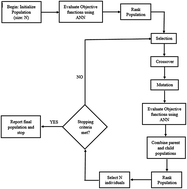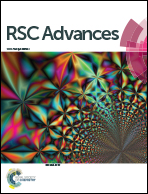Modeling and optimization of catalytic performance of SAPO-34 nanocatalysts synthesized sonochemically using a new hybrid of non-dominated sorting genetic algorithm-II based artificial neural networks (NSGA-II-ANNs)†
Abstract
The effects of ultrasound-related variables on the catalytic properties of sonochemically prepared SAPO-34 nanocatalysts in methanol to olefins (MTO) reactions were investigated. Different catalytic behaviors are observed which can be explained by the differences in the catalysts’ physicochemical properties affected by ultrasonic (US) power intensity, sonication temperature, irradiation time and sonotrode size. This result confirms that the activity of SAPO-34 catalysts improves with the rise in US power, time and temperature. In order to find a catalyst with the maximum conversion of methanol, maximum light olefins content and maximum lifetime, a hybrid of non-dominated sorting genetic algorithm-II based artificial neural networks (NSGA-II-ANNs) was used. The multilayer feed forward neural networks with back-propagation structures were implemented using different training rules in the neural networks approach to relate the ultrasound-related variables and the catalytic performance of SAPO-34 catalysts. A comparison between experimental and artificial neural network (ANN) values indicates that the ANN model with a 3–10–3 structure using the Bayesian regulation training rule has the best fit and can be used as a fitness evaluation inside the non-dominated sorting genetic algorithm-II (NSGA-II). Also, multiple linear regression (MLR) was used to predict these objective functions. The results indicate a poor fit for the objective functions with a low coefficient of determination. This confirms that the ANN technique is more effective than the traditional statistical-based prediction models. Finally, this ANN model was linked to the NSGA-II and Pareto-optimal solutions were determined by the NSGA-II.



 Please wait while we load your content...
Please wait while we load your content...